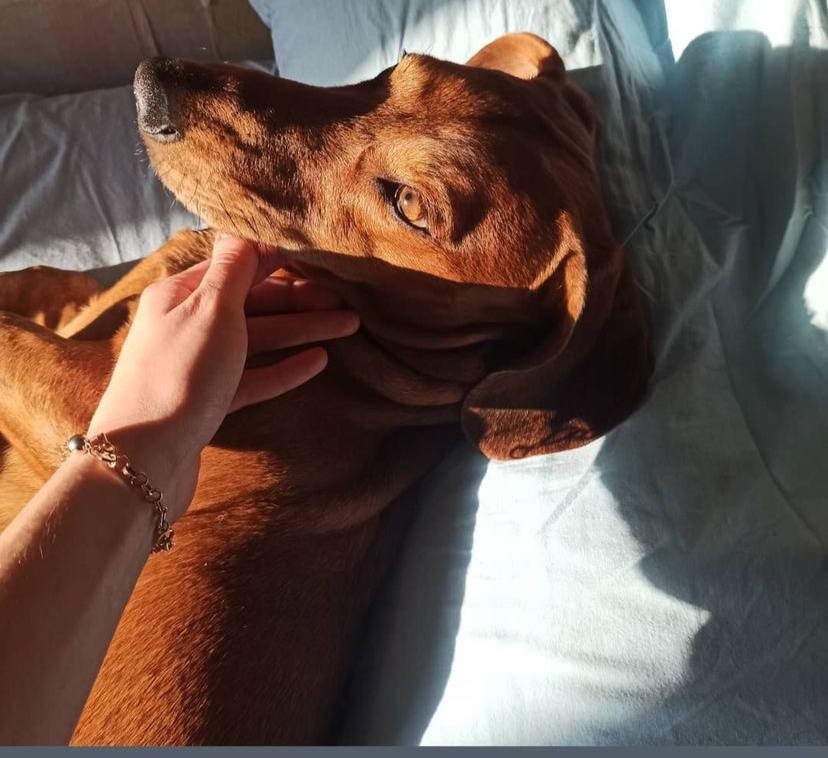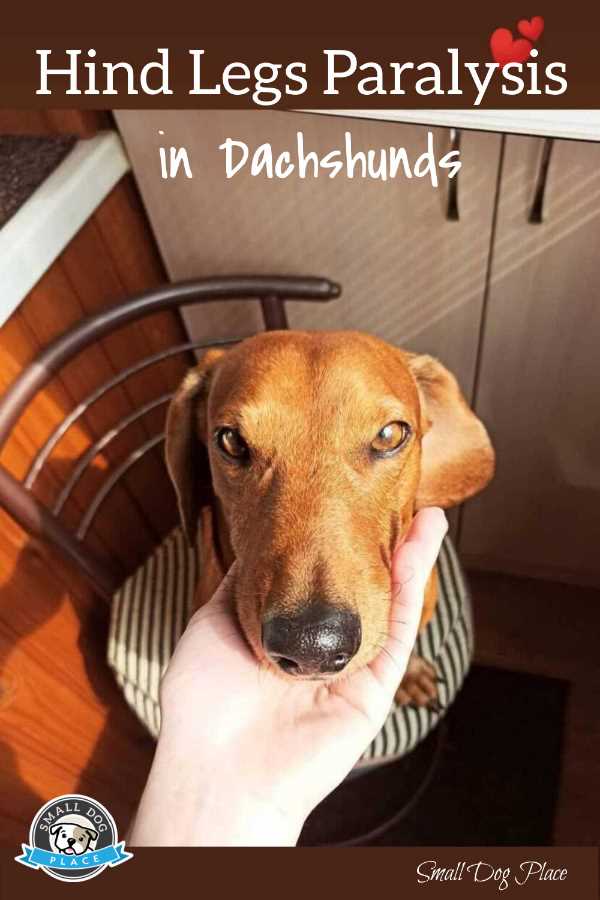- Small Dog Place Home
- Diseases
- Hind Legs Paralysis in Dachshunds
My Dog's Struggle with Hind Legs Paralysis in Dachshunds
Hind Legs Paralysis in Dachshunds by Laura Bolton |Published 11-29-2021
A dog's nervous system is the brain and spinal cord. The latter is located in the spinal canal formed by the neural arches. If elements of the spine are displaced or if the surrounding muscles and tendons become inflamed, the spinal cord nerve roots become pinched.
When a nerve is pinched, the dog experiences severe pain, and if the compression is not corrected, the animal may develop paralysis, so this pathology is considered dangerous and requires immediate treatment.
Depending on which part of the spine the compression occurred in, they distinguish cervical, thoracic, or sacral (sciatic) nerve entrapment.
Nerve root compression is most often the result of spinal disorders such as intervertebral hernia, spondylosis, or osteochondrosis.
 Dinar, a paralyzed Dachshund
Dinar, a paralyzed DachshundA pinched nerve in a dog can be caused by:
- Injuries that caused spine misalignment
- Increased stress on the spinal column
- Tumor in the spinal area
- Calcium metabolism disorders
- Frequent hypothermia.
Age and genetic predisposition also matter. Old dogs have slower bone repair processes, and vertebrae deform more easily.
Even a small amount of stress can shift vertebrae and pinch the nerve. Breeds of dogs with a large weight and a loose constitution are prone to develop this pathology. We all know how important and necessary special care for dachshunds is from the early years.
According to Dr. Glenn Ericsson, a practicing Orange County Veterinarian, medication can reduce the swelling at the point of injury and reduce the pain. However, in severe cases, medication has no effect and cannot stop the damage to the cord that the disc material can cause.
In these cases, surgery may be required to remove the disc material and/or open up the top of the vertebrae and allow the spinal cord room to expand. Most dogs improve essentially, however, there is no guarantee of success with surgery because never tissue is very delicate.
It is important to understand that these situations do happen often with dogs. Therefore, if you know that your dog breed is prone to spinal injuries, it is important to take care of his safety and health from his very childhood.
Even from puppyhood, a puppy needs special care. It is especially true for little dachshunds. Their spines are very delicate and traumatic. Puppies should not jump from high surfaces or climb on high things by themselves.
 Hind Legs Paralysis in Dachshunds. Photo Courtesy of the Author
Hind Legs Paralysis in Dachshunds. Photo Courtesy of the AuthorMy Personal Experience with Hind Legs Paralysis in Dachshunds
I have been a dachshund owner for 10 years. I love and care for my dog very much. He is a boy, and his name is Dinar. All this time, he led a very active life: swimming in rivers, going to nature, running very fast, participating in competitions, constantly played with other dogs and especially liked to play with children.
One day, when he was eight years old, we were playing ball in our apartment. He somehow hit the threshold with his paw. He immediately fell down and started whimpering badly.
He couldn't get up. Since it was almost night, we had to look for a veterinary clinic in our small town. It was not the best, but at least round-the-clock.
They examined Dinar, injected some painkillers, and just said that if he cannot walk in 3 days still, he will have to be put to sleep. It was a shock.
The next morning, we took him to an expensive vet clinic. We were told that he had spinal cord compression and, therefore, could not walk.
According to the article published by PetMD Editorial, when the nerves of a dog’s spinal cord are compressed, the nerve impulses are not able to transmit their signals to the limbs, bladder, etc.
If the damage is severe enough, paralysis and loss of bladder and bowel control can occur. His hind legs were paralyzed, and so he was just dragging them behind him. We have been prescribed a huge amount of shots, massages, acupuncture, and hydrotherapies for recovery.
Treatment methods that will work for Hind Legs Paralysis in Dachshunds
Hydrotherapy
A dog pool, water treadmill, or a river, for example, can be used for both cats and dogs. If the animal has no skin lesions, hydrotherapy helps build or maintain the muscular frame.
The water treadmill is effective in restoring motor function. When my dachshund was new to the sport, he could only swim for 10 minutes until his endurance level was reached.
For dogs recovering from injury or illness, progressive light exercises are the key. Each visit will increase his stamina. Your 30-minute swimming session is the industry standard for the average dog.
Massage
For lying animals, massage is an obligatory daily procedure that helps in the prevention of bedsores and stiffness of muscles and joints.
The massage should begin with light stroking movements. It is not necessary to start with the therapeutic actions right away. You should get the pet's trust and consent to the manipulation.
You can go to a veterinarian for the procedure or learn how to massage yourself. The doctor will show you how to act correctly so that you do not harm your pet.
The technique is based on the following basic movements: stroking (light and flat), kneading, shaking, vibrating movements, rubbing, and tapping.
The best way to do this is with the fingertips or with the palm of your hand. Stroking movements contribute to relaxation, muscle relaxation, and reassurance for the animal. With their help, contact is established with the four-legged patient.
Veterinary Acupuncture
Veterinary acupuncture is a method of physical therapy aimed at complementing and enhancing the main method of treatment, both in the conservative management of the patient and in the pre-and postoperative period.
It is used for both cats and dogs. There are two schools of veterinary acupuncture: classical Chinese and Western European.
The duration of the session itself is no more than 20 minutes - this is the generally accepted time for this procedure. The number of points that can be stimulated simultaneously is also limited: 15 needles for dogs.
The specialist quickly finds the right spots, so it takes only a couple of minutes to place the needles.
Home Treatments for Hind Legs Paralysis in Dachshund
Massages, Injections, Hydrotherapy in the River, and TLC saved Dinar
In addition to treatments, we also took care of the dog at home. I have learnt how to give special injections, therapeutic massages, and many other procedures that are safe to do at home.
Our family took turns carrying him out and back in our arms, we gave him special massages every day, and we went to the river once a week so that he could spend time in nature and the water at the same time.
The best part was that all this time, Dinar was as positive as possible. He chased dogs outside (even though he couldn't move his hind legs and tail at all); he was perky and cheerful all the time. He would let himself get shots and procedures because he knew it was good for him.
The three days the doctors mentioned had passed, but he still could not walk. Of course, no one even thought of putting him to sleep.
Dinar was very cheerful even despite his paralyzed paws. All this treatment lasted a month. And one day, meeting my dad from work,
Dinar wagged his tail for the first time. Our joy was overflowing. It was clear that he was getting better. As a result, after some more time, we noticed that he was trying to get up on his paws, and he was slowly doing it.
We didn't stop doing all the procedures we had done before. After two or three months, he was fully on his paws. He still wasn't walking very well; he couldn't run for a long time but still was doing great.
As a result, now, a year later, he walks just like he did before; he runs, swims, and chases dogs. The only thing is that he no longer lifts his paw when he is tagging trees, but that's not a big deal at all.
Conclusion
Just like people, our pets can be injured and appear in very bad conditions. It doesn’t mean that we should leave them face-to-face with their issues. No matter what happens and how complicated the situation is, we have to love our pets and take care of them. Only your love and dedication can help them feel and get better.
I still worry about my Dinar every day.
I give him massages from time to time, take him to the river in the summer, and I don't let him walk up and down the stairs by himself.
It is important to understand that such an illness is stressful not only for the dog but first and foremost for the owner. These experiences are very painful.
I know that there are many cases where dogs with these problems do not recover and stop walking with their hind legs forever. But that's just a reason to love them only more. To appreciate that they are still cheerful and surprisingly fast.
Your dog can sense your mood. You are a very important and necessary support for your doggie. Don't let your pet down!
Hind Legs Paralysis in Dachshunds: Pin for Future Reference
Hind Legs Paralysis in Dachshunds
Author Bio
Laura Bolton is a Dinar’s owner and PR-Manager in VeePN company, which specializes in security products and data privacy. Laura told her story to share her experiences and advice with readers. She hopes that people will treat their pets with care and that all the dogs will be healthy.
About Janice (author and voice behind this site)
Janice Jones has lived with dogs and cats for most of her life and worked as a veterinary technician for over a decade. She has also been a small-breed dog breeder and rescue advocate and holds academic training in psychology, biology, nursing, and mental health counseling. Her work focuses on helping dog owners make informed, responsible decisions rooted in experience, education, and compassion.
When not writing, reading, or researching dog-related topics, she likes to spend time with her six Shih Tzu dogs, her husband, and her family, as well as knitting and crocheting. She is also the voice behind Miracle Shih Tzu and Smart-Knit-Crocheting
Does This Article Deserve Your Thumbs Up?
We always appreciate your support and encouragement. Your thumbs up means so much to us. Please like this article.
If you find this page or any page on Small Dog Place Helpful, or useful in anyway, I'd love it if you would click the small heart found on the bottom right of each page.
You can also share or bookmark this page -- just click on the:

Free Monthly Newsletter
Sign Up for Our Free Newsletter and get our Free Gift to You.
my E-book, The Top 10 Mistakes People Make When Choosing a Dog (and how to avoid them)


